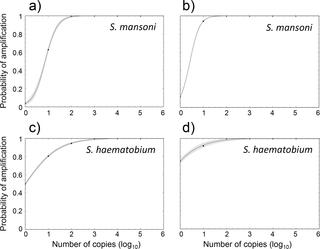当前位置:
X-MOL 学术
›
PLOS Negl. Trop. Dis.
›
论文详情
Our official English website, www.x-mol.net, welcomes your feedback! (Note: you will need to create a separate account there.)
Schistosoma species detection by environmental DNA assays in African freshwaters.
PLOS Neglected Tropical Diseases ( IF 3.8 ) Pub Date : 2020-03-23 , DOI: 10.1371/journal.pntd.0008129 Hind Alzaylaee 1, 2 , Rupert A Collins 1 , Gabriel Rinaldi 3 , Asilatu Shechonge 4 , Benjamin Ngatunga 4 , Eric R Morgan 1, 5 , Martin J Genner 1
PLOS Neglected Tropical Diseases ( IF 3.8 ) Pub Date : 2020-03-23 , DOI: 10.1371/journal.pntd.0008129 Hind Alzaylaee 1, 2 , Rupert A Collins 1 , Gabriel Rinaldi 3 , Asilatu Shechonge 4 , Benjamin Ngatunga 4 , Eric R Morgan 1, 5 , Martin J Genner 1
Affiliation

|
BACKGROUND
Schistosomiasis is a neglected tropical parasitic disease associated with severe pathology, mortality and economic loss worldwide. Programs for disease control may benefit from specific and sensitive diagnostic methods to detect Schistosoma trematodes in aquatic environments. Here we report the development of novel environmental DNA (eDNA) qPCR assays for the presence of the human-infecting species Schistosoma mansoni, S. haematobium and S. japonicum.
METHODOLOGY/PRINCIPAL FINDINGS
We first tested the specificity of the assays across the three species using genomic DNA preparations which showed successful amplification of target sequences with no cross amplification between the three focal species. In addition, we evaluated the specificity of the assays using synthetic DNA of multiple Schistosoma species, and demonstrated a high overall specificity; however, S. japonicum and S. haematobium assays showed cross-species amplification with very closely-related species. We next tested the effectiveness of the S. mansoni assay using eDNA samples from aquaria containing infected host gastropods, with the target species revealed as present in all infected aquaria. Finally, we evaluated the effectiveness of the S. mansoni and S. haematobium assays using eDNA samples from eight discrete natural freshwater sites in Tanzania, and demonstrated strong correspondence between infection status established using eDNA and conventional assays of parasite prevalence in host snails.
CONCLUSIONS/SIGNIFICANCE
Collectively, our results suggest that eDNA monitoring is able to detect schistosomes in freshwater bodies, but refinement of the field sampling, storage and assay methods are likely to optimise its performance. We anticipate that environmental DNA-based approaches will help to inform epidemiological studies and contribute to efforts to control and eliminate schistosomiasis in endemic areas.
中文翻译:

通过非洲淡水中的环境DNA分析检测血吸虫物种。
背景技术血吸虫病是一种被忽视的热带寄生虫病,与全世界范围内的严重病理,死亡率和经济损失有关。用于疾病控制的程序可能会受益于在水生环境中检测血吸虫的特异性和灵敏的诊断方法。在这里,我们报道了人类感染曼氏血吸虫,血吸虫和日本血吸虫的新型环境DNA(eDNA)qPCR分析方法的发展。方法学/主要发现我们首先使用基因组DNA制剂测试了在这三个物种上的分析特异性,该基因组DNA制备物成功扩增了靶序列,并且在三个焦点物种之间没有交叉扩增。此外,我们使用多种血吸虫物种的合成DNA评估了测定的特异性,并表现出很高的整体特异性;然而,日本血吸虫和血吸虫的检测显示出具有非常密切相关物种的跨物种扩增。接下来,我们使用来自含有受感染宿主腹足动物的水族箱的eDNA样品测试了曼氏梭菌测定的有效性,并揭示了所有受感染水族箱中都存在的目标物种。最后,我们使用来自坦桑尼亚的八个离散天然淡水站点的eDNA样品评估了曼氏葡萄球菌和血生沙门氏菌测定的有效性,并证明了使用eDNA建立的感染状况与寄主蜗牛体内寄生虫流行的常规测定之间的强烈对应。结论/意义总的来说,我们的结果表明,eDNA监测能够检测淡水体内的血吸虫,但是对现场采样进行了改进,存储和化验方法可能会优化其性能。我们预期基于环境DNA的方法将有助于为流行病学研究提供信息,并有助于控制和消除流行地区的血吸虫病。
更新日期:2020-03-24
中文翻译:

通过非洲淡水中的环境DNA分析检测血吸虫物种。
背景技术血吸虫病是一种被忽视的热带寄生虫病,与全世界范围内的严重病理,死亡率和经济损失有关。用于疾病控制的程序可能会受益于在水生环境中检测血吸虫的特异性和灵敏的诊断方法。在这里,我们报道了人类感染曼氏血吸虫,血吸虫和日本血吸虫的新型环境DNA(eDNA)qPCR分析方法的发展。方法学/主要发现我们首先使用基因组DNA制剂测试了在这三个物种上的分析特异性,该基因组DNA制备物成功扩增了靶序列,并且在三个焦点物种之间没有交叉扩增。此外,我们使用多种血吸虫物种的合成DNA评估了测定的特异性,并表现出很高的整体特异性;然而,日本血吸虫和血吸虫的检测显示出具有非常密切相关物种的跨物种扩增。接下来,我们使用来自含有受感染宿主腹足动物的水族箱的eDNA样品测试了曼氏梭菌测定的有效性,并揭示了所有受感染水族箱中都存在的目标物种。最后,我们使用来自坦桑尼亚的八个离散天然淡水站点的eDNA样品评估了曼氏葡萄球菌和血生沙门氏菌测定的有效性,并证明了使用eDNA建立的感染状况与寄主蜗牛体内寄生虫流行的常规测定之间的强烈对应。结论/意义总的来说,我们的结果表明,eDNA监测能够检测淡水体内的血吸虫,但是对现场采样进行了改进,存储和化验方法可能会优化其性能。我们预期基于环境DNA的方法将有助于为流行病学研究提供信息,并有助于控制和消除流行地区的血吸虫病。


























 京公网安备 11010802027423号
京公网安备 11010802027423号